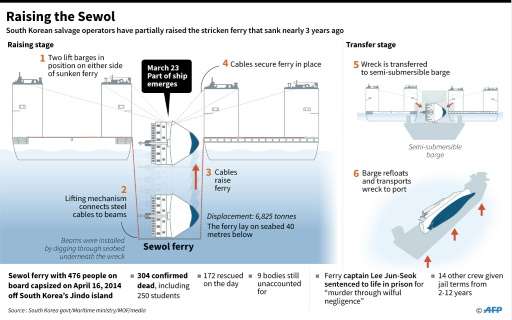Salvage of South Korea's Sewol ferry: the facts

South Korea's sunken Sewol ferry emerged from the waters on Thursday, nearly three years after it sank with the loss of more than 300 lives in one of the country's worst maritime disasters.
The painstaking job of lifting the 6,825-tonne ship lying on its side 44 metres (145 feet) below the surface has been described as a battle between man and nature.
The sea off the southwestern island of Jindo is known for its strong currents, which have been blamed for dozens of accidents and the deaths of two divers involved in the search and rescue on the Sewol.
Unfavourable conditions also played a role in a series of delays in the salvage operations, with an original deadline of July 2016 pushed back until now.
'Lifting beams'
The process began last year with divers installing a total of 33 "lifting beams" underneath the wreck—often by digging through the seabed below the ferry.
The lifting beams were then linked on both ends by 66 steel cables to two giant barges floating on either side of the vessel, which since Wednesday have pulled up the cables in tandem.
The process is slow, not just because of the weight of the ship—estimated to have gone up to 8,500 tonnes with the silt piled up inside—but due to constant monitoring and adjustments needed to keep it level.
Semi-submersible
Once the top of the wreck is 13 metres above the waves, a semi-submersible waiting nearby will be positioned underneath to raise it the rest of the way, before the water and fuel are drained out of the ship.
Then the submersible will sail to Mokpo—a major port about 87 kilometres (54 miles) away.
Search for victims
The recovery of the hull is the prelude to the long, arduous job of searching the giant ferry for the bodies of nine victims still unaccounted for.
Because of their possible presence in the ferry, raising it intact—rather than cutting it into pieces—has been a key demand of the victims' families.
Much of the interior of the ship—which would be 22 metres wide if upright—have corroded after years in the water, adding to the difficulties.
$90 million
More than 400 people were working around the clock on the operation.
Seoul expects to spend a total of 102 billion won ($90 million) on the overall salvage.
© 2017 AFP



















